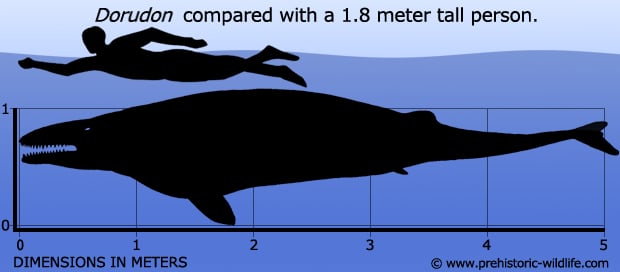In Depth
Dorudon is a good example of some of the many primitive whales that were swimming in the world’s oceans during the Eocene period. As an early cetacean, Dorudon was a dedicated predator of other marine creatures that may have included everything from fish to other marine mammals. Dorudon itself does bear a strong resemblance to the much larger Basilosaurus that was also swimming in the same waters and at the same time as Dorudon. This led to early speculation about Dorudon actually representing juvenile specimens of Basilosaurus; however more in depth study as well as the discoveries of actual Dorudon juveniles has since quashed this theory.
Juvenile Dorudon (which would have been called calves like other juvenile whales) fossils have been seen to have tooth marks on them that seem to have been caused by the much larger Basilosaurus. This is evidence for a clear predator prey relationship where while Dorudon were predators, they in turn where preyed upon by other bigger predators. This relationship was well illustrated in the episode Whale Killer of the BBC documentary series Walking with Beasts. Basilosaurus was not the only threat to Dorudon however as giant sharks like C. angustidens were also hunting in the world’s oceans.
Further Reading
– Description of the teeth of a new fossil animal found in the Green Sand of South Carolina. Proceedings of the Academy of Natural Sciences of Philadelphia 2(9):254-256 – R. W. Gibbes – 1845. – On the fossil genus Basilosaurus, Harlan, (Zeuglodon, Owen,) with a notice of specimens from the Eocene Green Sand of South Carolina – Journal of the Academy of Natural Sciences of Philadelphia 1 – Robert Wilson Gibbes – 1847. – A Descriptive Catalogue of the Tertiary Vertebrata of the Fay�m, Egypt. – London: British Museum (Natural History). 26 pp. 255–257. – C. W. Andrews – 1906. – Marine Mammals (Cetacean and Sirenia) from the Eocene of Gebel Mokattam and Fayum, Egypt: Stratigraphy, Age, and Paleoenvironments – University of Michigan Papers on Paleontology 30: 1–84 – P. D. Gingerich – 1992. – Form, Function, and Anatomy of Dorudon atrox (Mammalia, Cetacea): An Archaeocete from the Middle to Late Eocene of Egypt – Papers on Paleontology (University of Michigan) 34. – Mark D. Uhen – 2004.











